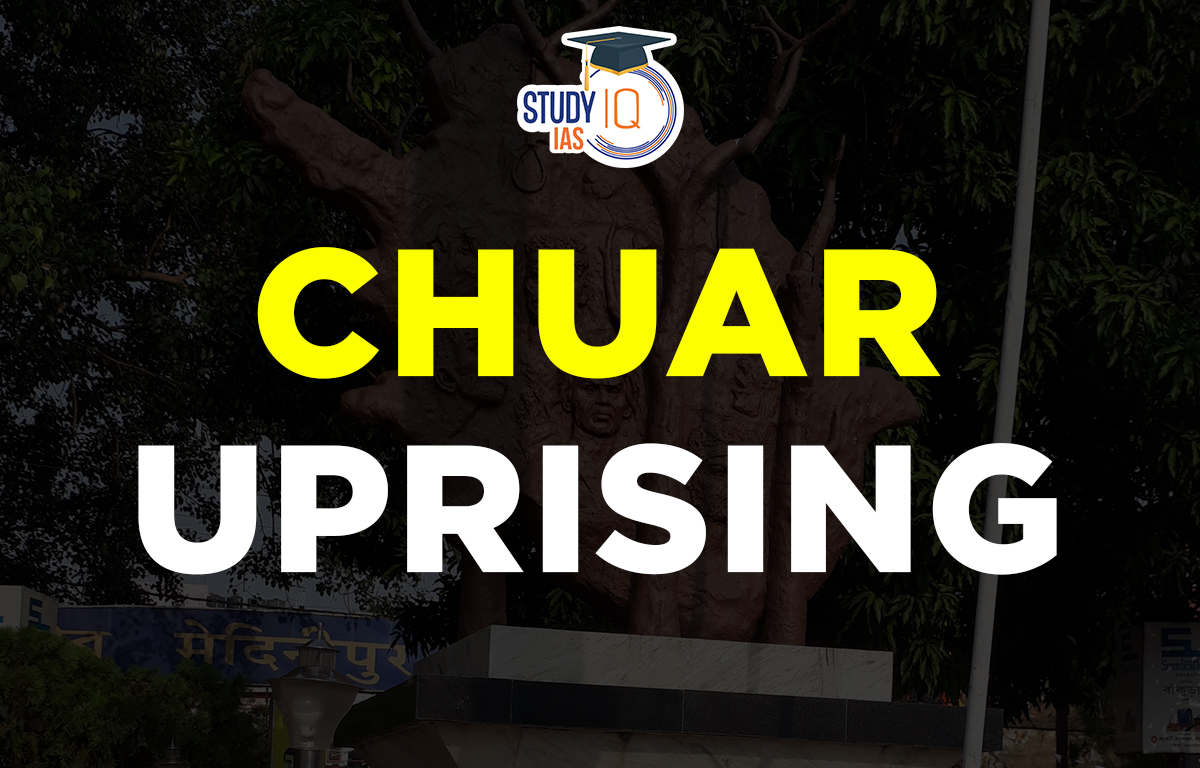Table of Contents
Chuar Uprising
A string of peasant uprisings against the East India Company that took place between 1771 and 1809 in the vicinity of the West Bengali villages of Midnapore, Bankura, and Manbhum are known as the Chuar uprising. The onerous land revenue policy of the East India Company, which put their economic survival in danger, sparked the rebellion. Jungle Mahal Rebellion is another name for the Chuar Uprising. You will learn about the Chuar Rebellion (1776) in this article, which will help you with your preparation for the UPSC Civil Service Exam.
Read More: Paika Rebellion
Chuar Uprising History
The Bhumij tribes known as the Chuars were descended from the Mundari majority. Following their departure from the Chotanagpur plateau, they made significant inroads into the Bengali districts of Midnapur, Bankura, and Purulia. Most of these individuals were farmers and hunters, while some also worked for the local zamindars. Particularly in the highlands between Barabhum and Ghatsila, the Chuars were a significant ethnic group in Manbhum and Barabhum.
They had a type of feudal tenure over their lands, but they had little ties to the land and were willing to switch from farming to hunting at the whim of their zamindars or jungle chiefs. These zamindars of the forests hired Chuars as paiks (guards who policed the community). Chief paiks were referred to as sardars. Each stage of the Chuar rebellion had its own characteristics, commanders, and epicenter.
Read More: Tribal Movements in India
Chuar Uprising Reason
The Famine, increased taxes, burdensome demands, and economic hardship brought on by famines were frequently cited causes of revolts during that time. In Bengal, local tribals were referred to as Char or Chuar, two pejorative terms that both mean “pig.” Durjan Singh, a dispossessed zamindar who led the uprising and his 1500 supporters, caused chaos, served as its leader.
He ruled over 30 villages after attacking the East India Company’s buildings. With the assistance of the local landlords, the Brits were able to put down the uprising with the utmost cruelty and duplicity. In the process, some 200 insurgents were put to death.
Read More: Ahom Revolt
Chuar Uprising Significance
The first Chuar Uprising broke out as a result of the forest zamindars’ expanding wealth. It was challenging to raise the money because the woodland area didn’t produce much. In addition, the zamindars were furious in 1767 when the British inhabitants of Midnapur were told to destroy their mud forts. Jagannath Singh, the zamindar of Ghatsila (or the ruler of Dhalbhum), organised a rebellion in 1768 and had thousands of Chuar followers follow him. The Company’s administration gave up..
In 1771, the Chuar sardars Dubraj, Subla Singh, and Shyam Ganjan of Dhadka rose up in rebellion. The uprising was suppressed this time, though. In 1798, the biggest uprising was headed by Durjan (or Durjol) Singh. Local paik employment became outdated due to the East India Company’s tax and administrative policies (such as the Permanent Settlement) as well as the police restrictions implemented in rural Bengal. Local paik employment was finally replaced by professional police.
Disgruntled paiks and ordinary Chuars joined the forest zamindars in the 1798 rebellion of the Chuars. The Bengal Rules caused Durjan Singh to lose his position as zamindar of Raipur. To stop the sale of Raipur’s estate, his allies, a band of 1,500 Chuars, carried out violent activities in Raipur in May 1798. The uprising was severely put down by the British in 1799. Madhab Singh, the brother of the raja of Barabhum, Raja Mohan Singh, the zamindar of Juriah, and Lachman Singh of Dulma were additional Chuar lords.
Zamindars, paiks, and common Chuars were among the participants in the uprisings who were all somehow associated with the land. It’s possible to say that two different lifestyles collided. The rebels had previously resided in a tiny town and led an agrarian lifestyle. They experienced a new situation that altered their way of life when colonial soldiers invaded their territory. Also, they didn’t want to admit outsiders (or non-Adivasis). Some historians prefer to refer to this as the Rebellion of the Jungle Mahal because they feel that the term “Chuar” is derogatory.
Read More: Anglo-Bhutanese War
Chuar Uprising UPSC
The Brits were able to put down the rebellion with the greatest amount of force and trickery with the help of the local landlords. Almost 200 insurgents were put to death during the procedure. Since “Chuar” was a derogatory term used by the ruling class, some historians are against using it to refer to this rebellion. This rebellion is being referred to as the “Freedom Struggle of the JangalMahal” by some.’
Read More: Anglo-Afghan War


 Important Lakes of India, State wise and...
Important Lakes of India, State wise and...
 Buddhism History, Origin, Sect, Councils...
Buddhism History, Origin, Sect, Councils...
 Andaman and Nicobar Islands, History, Cl...
Andaman and Nicobar Islands, History, Cl...





















